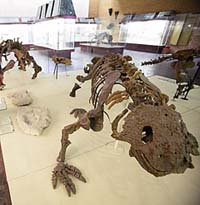Russian scientists pick up the trail of dinosaurs
Russian paleontologists discovered the first location of the prints of large terricole reptiles in the European part of Russia
Russian paleontologists discovered the first location of the prints of large terricole reptiles in the European part of Russia. The discovery was made on the river  Sukhona in Vologodskaya region. The tracks of mysterious species were found on two narrow limestone bassets located one above the other one meter above the sea level.
Sukhona in Vologodskaya region. The tracks of mysterious species were found on two narrow limestone bassets located one above the other one meter above the sea level.
Last summer the expedition of the Paleontological Institute of the Russian Academy of Sciences was working on the border of Vologodskaya and Arkhangelskaya regions on the river Sukhona. In the deposits of the Permian period (which are about 250 million years old) bones of ancient animals are frequently found. So while the main part of the group was excavating the assumed place of the remains, one of the members of the expedition Sergey Petuhov decided to examine the place on the other bank of Sukhona that was poorly explored. It is there that he found the traces of the ancient creatures in fossilized rock. Back at the camp Petuhov showed to his amazed colleagues a small piece of stone with a paw print. A sudden discovery changed the scientists' plans at once. They started scrutinizing the traces found. As a result, they managed to clear away two track paths situated one hundred meters from each other. They were left by large animals belonging more likely to the same species. The 30-meter path left by a larger specimen had 12 prints. The smaller animal left twelve prints. The prints look different. Some of them are more distinct, surrounded by muddy roundel with the prints of dactyls and claws that can be distinguished. The largest prints are more than 35 meters across and up to 5,5 centimeters deep. Other prints are greatly degraded.
Later paleontologists found several more paw prints in one of Sukhona’s effluents Strelna. The river is only 1,5 meters deep there and the bottom is seen very well. “This place used to be the bottom of a large lake, where animals were wandering in different directions”, the head of the expedition Doctor of Biology Yuri Gubin says. “The prints hardened in mud are the evidence of this”. Members of the expedition had to work in water up to their knees to examine these prints. Every morning several people entered the water, stood in a line across the river, took the brooms and cleared the sticking silt from the prints. After the clearing the prints were well seen during the whole day.
All of the prints that were discovered are similar. All of them belong to quadrupedal pentadactyl animals that were more than a meter long. The prints have a shape of equilateral triangle with roundish angles. A thorough study of the prints showed that the nail bones protrude greatly, which means that a thick skinny membrane could be found between the dactyls. The example of mammals shows that the higher is the speed of the movement the less clear the prints are. Assuming this is also true for the ancient creatures the clearness of their prints shows that they moved slowly.
Experts from the Paleontological Institute of the Russian Academy of Sciences could not determine which of the prehistoric animals the prints belonged to. The terrestrial beds of the north of European Russia have been studied for more than a hundred years. That is why the composition of the ancient fauna that inhabited this area is quite well known. Among those who inhabited this area were labirynthodonts, pareiasaurs, and dicynodonts. Scientists were studying available information on groups of fossils belonging to the Permian period. In the end they came to the conclusion that the prints belonged to pareiasaurs, distant ancestors of the present-day tortoises that are called cheeky pangolins.
Paleontologists more than once studied the bones of pareiasaurs and they know a lot about these species. Pareiasaurs appeared on the Earth about 250 million years ago, in the second half of the Permian period of Paleozoic. There were such species among them that lived in the water all the time. The analysis of the pareiasaur's skeleton leads to the conclusion that the animal had a big belly and short legs. That is why they could move on the land only with difficulty. However, there were also species that preferred spend most of their time on land. They were wandering along the banks of swamps and in shallow waters searching for plants and seaweeds. The climate at that time was warm in all the seasons and the pangolins never were short of food. Pareiasaurs were herbivores. Their small teeth could grind only soft food. These reptiles were harmless for other animals. Nevertheless, they could escape from the dinner table of the predators. They were protected from the enemies by the real armor. The animal's body was covered with osteoscutes that turned into the shell in their descendants. The bones also helped scientists to determine an approximate weight of the animal. Reptiles that left the track paths on the bank of the river Strelna were not the largest ones and weighed about 200-300 kilograms. Meantime, pareiasaurs, whose skeletons are displayed in the halls of the Paleontological Museum, weighed as much as 700-800 kilograms.
“The fact of discovering the track paths itself presents a great interest,” Yuri Gubin thinks. In the ancient times the area where the discovery was made had a humid climate. The excess of the water led to the floods of vast territories and the formation of large flood-lands. During the short periods of drought the river flow was reduced. The area of the surface water diminished as well and the zones of drying loamy slit, covered in thick plants appeared at its periphery. Such landscapes were favorite places for pastures of herbivore reptiles. As a rule, there are no tracks found in the places where the soil was hard. On the other hand, the tracks are found on softer and dampened soils. The mechanism of formation of the prints on Sukhona banks could be the following: at first the water went away, then a large field of the drying lime mud covered with vegetation was formed. It is here that the reptiles left their numerous prints. Afterwards the slit dried out completely and during the next flood the prints became covered with a layer of clay.
Studying the traces of the ancient animals' life is the subject of one of the areas of paleontology, ichnology. The prints of fossilized bodies and paws as well as bones help scientists in studying life forms that existed in prehistoric times. “Almost all of the information about the ancient creatures that we have today was obtained thanks to the studying of their prints,” Yuri Gubin claims.
Ichnology also uses the prints of ancient species as a means of dating different geological layers. Researchers, for example, take samples of layers in two different places, compare them and if it turns out that both contain prints of the same ancient species it can be assumed that the age of the layers examined is almost the same.
Many prints of the ancient species were found on the territory of Western Europe and America. In the Eastern Europe, in Russia particularly, such discoveries did not take place for a long time. Meanwhile, Russian territory is rich in Permian deposits located on land around the rivers, lakes and swamps. Remains of quadrupedal animals had been discovered here before. However, the prints were discovered here for the first time.
“This discovery is a big event in the scientific world,” says Yuri Gubin unable to hide his delight. “Until recently Russian scientists were only discovering bones of the animals living at that period. At last we have found their traces”.
Ekaterina Gorbunova
Subscribe to Pravda.Ru Telegram channel, Facebook, RSS!





